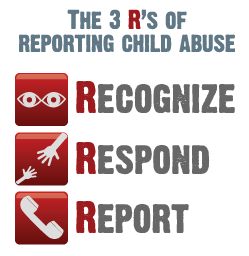Child Abuse Prevention: An Educator’s Role
 Child abuse can be a tricky topic for teachers.
Child abuse can be a tricky topic for teachers.
Not only do we not want to think about something so horrific, but often, educators are not sure what exactly constitutes child abuse, what to look for as indicators, and, perhaps most of all, when to say something (and how to do it!). Teachers, however, play an essential role in the prevention of child abuse and neglect. According to www.childwelfare.gov, educators are invaluable to this cause because of their close and consistent contact with children, their unique opportunity to advocate for children, and their legal obligation to report suspicions of abuse. Furthermore, studies demonstrate that a positive relationship with a supportive adult, like a teacher, can promote resiliency in children who have been victims of abuse.
Spotting Signs of Child Abuse
Spotting signs of child abuse can be tricky, and teachers rarely receive comprehensive training on what to look for. The most readily observable signs of abuse, of course, are obvious physical signs of maltreatment. This could include something as simple as a bruise, or something more serious, such as broken bones or bruises. Other physical signs of abuse and neglect may be more subtle, such as indications of malnutrition or a child wearing clothing inappropriate for the weather. Although children, of course, can sustain injuries in the course of normal play, this normal behavior is most likely to affect the bony edges of the body, such as knees, elbows, forearms, or brows. Soft tissue areas, such as cheeks, buttocks, and thighs, are not normally injured in this manner. Furthermore, adults should be more suspicious of bruises distinctly shaped like an object (such as a hand, belt buckle, or teeth marks).
Many victims of abuse manifest their distress with behavioral indicators, such as age-inappropriate sexual behaviors, aggression toward younger children, oppositional or defiant behavior, fear of adults, self-destructive behavior, fear of going home, extreme risk-taking, or regressive behavior. At times, teachers may just have a “gut feeling” that something is wrong with a student or their home situation.
 Neglect
Neglect
Child neglect, although a serious form of abuse, may not manifest physically and, as a result, can be more difficult to spot. Neglect is the most common type of child abuse, accounting for more than half of reported cases each year. Child neglect is also more likely to end in the death of a child than any other form of abuse.
Adding to the confusion, it can be difficult for an outsider to distinguish between signs of living in poverty (not, in and of itself, a type of neglect) and true abuse. Neglect is defined as a caregiver’s inattention to the basic needs of a child, such as food, clothing, shelter, medical care, and supervision. This form of abuse is typically chronic and, as such, will likely seem normal to the child, who may not ever reach out for help.
For all of these reasons, studies show that educators are less likely to report neglect than any other type of child maltreatment. Some signs of neglect to look for are: children stealing or hoarding foods, chronic attendance problems, difficulty staying awake at school, or consistently poor hygiene.
Sexual Abuse
Sexual abuse is defined as inappropriate adolescent or adult sexual behavior with a child. This means that the abuse can be committed by a person under the age of 18 who is either much older than the child, or in some position of power over the child. Contrary to the “stranger myth,” the vast majority of child sexual abuse cases are perpetrated by adults close to the child.
Recently, more attention has been given to the growing problem of sexual abuse of children via the internet. A recent study shows that 49 percent of youths solicited online did not report the incident to anyone. Some signs that a child may be involved with a sexual predator online are: child prevents others from viewing the computer screen, has disks or files that others are not able to see, takes significant time away from schoolwork to use the computer, or begins exhibiting secretive behavior while using the computer.
Other Types of Abuse
In addition to physical abuse and neglect, children may be subjected to emotional maltreatment, which may consist of blaming, belittling, or constant rejection. Children may show signs of this form of abuse through behavioral issues, developmental lags, or speech disorders.
Reporting Abuse
 Florida law (Florida State Statute Chapter 39) requires that “any person who knows, or has reasonable cause to suspect, that a child is abused, neglected, or abandoned by a parent, legal custodian, caregiver, or other person responsible for the child’s welfare shall immediately report such knowledge or suspicion to the Florida Abuse Hotline of the Department of Children and Families.”
Florida law (Florida State Statute Chapter 39) requires that “any person who knows, or has reasonable cause to suspect, that a child is abused, neglected, or abandoned by a parent, legal custodian, caregiver, or other person responsible for the child’s welfare shall immediately report such knowledge or suspicion to the Florida Abuse Hotline of the Department of Children and Families.”
Under this same law, teachers and other school personnel are named as mandatory reporters. Persons belonging to this category who fail to report their knowledge or reasonable suspicions of abuse can be charged with a third-degree felony (with a maximum prison term of five years). Furthermore, subsections 39.205(3) and (4) of the Florida Statutes provide additional penalties for educational institutions whose personnel fail to report child abuse that takes place on the campus during school events or functions. This law subjects institutions to a $1 million fine for each failure to report.
The Florida Abuse Hotline will accept reports on children that are unmarried, under the age of 18, and a Florida resident who can be found in Florida (or a non-resident harmed in Florida). The child may have been harmed or is believed to be threatened with harm by a parent, legal custodian, caregiver, or other person responsible for the child’s welfare.
When making a report, specific descriptions are vital.
When possible, it is helpful to provide the names, dates of birth, race, and gender for all people involved. Other information that can be helpful to investigators includes: addresses, disability information, and the nature of the relationship between the child and the perpetrator.
The most important thing is to make reports as quickly as possible, so do not delay reporting to obtain further information.
The abuse counselor who answers the phone will inform the caller whether the information provided meets statutory requirements for a report, and may also provide information about relevant resources that may help the child.
Often times, adults are reluctant to report abuse until they are absolutely certain their suspicions are accurate. Unfortunately, in this search for definitive evidence there are missed opportunities to save a child from abuse.
Aside from reporting abuse that may have already occurred, schools can do a lot to help prevent child abuse.
In providing a safe and positive environment for children and adolescents, educators can help them to make informed decisions about their own health. Teachers provide positive role models and can give students opportunities for participation that can increase self-esteem. Additionally, in building strong, trusting relationships with students, educators can promote effective communication, which is one of the most important components of child abuse prevention.
Reporting Resources
- Report online at https://reportabuse.dcf.state.fl.us
- Call 1-800-962-2873
- Florida Relay 711 or TTY 800-453-5145
- Fax your report to 800-914-0004
Post by Lori Wurtzel, FLVS Professional Learning Specialist, Teacher
Citations/Resources
www.childwelfare.gov
http://www.myflfamilies.com/service-programs/child-welfare/capm
http://www.stopitnow.org/ohc-content/what-teachers-and-child-care-providers-can-do-to-prevent-child-sexual-abuse
http://www.unicef.org/teachers/protection/prevention.htm
